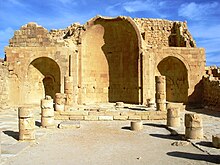| Revision as of 01:52, 18 August 2009 editDrilBot (talk | contribs)152,046 editsm Check Misplaced Pages cleanup (duplicate references) + gen. fixes (supervised)← Previous edit | Revision as of 06:34, 9 September 2009 edit undo93.172.171.239 (talk)No edit summaryNext edit → | ||
| Line 1: | Line 1: | ||
| ]]] | ]]] | ||
| The '''architecture |
The '''architecture in Israel''' is composed of many different styles of building brought in by those who have occupied the country over the ages, sometimes modified to suit the local climate and landscape. Fortified ] castles, ] madrassas, ] churches, ] houses, ]-style modernist buildings, ] arches and minarets, Russian Orthodox onion domes, and soaring glass-sided skyscrapers - all are part of the architecture of Israel. | ||
| Architecture of Israel is a professional magazine. | |||
| First published in 1988, Architecture of Israel is a high quality publication dealing with local architectural issues within the global context. Written by and for architects, AI is composed of unique articles focused on a diversity of contemporary issues, enhanced by outstanding photography featuring some of the world's most compelling architectural creations. As such, AI is regarded the leading architectural magazine in the Middle East, and one of the best of its kind in the world. | |||
| Editor: Architect Dr. Ami Ran | |||
| Editorial director: Rachel Ben Aharon | |||
| www.aiq.co.il | |||
| ], ]]] | ], ]]] | ||
Revision as of 06:34, 9 September 2009
The architecture in Israel is composed of many different styles of building brought in by those who have occupied the country over the ages, sometimes modified to suit the local climate and landscape. Fortified Crusader castles, Islamic madrassas, Byzantine churches, Templer houses, Bauhaus-style modernist buildings, Arab arches and minarets, Russian Orthodox onion domes, and soaring glass-sided skyscrapers - all are part of the architecture of Israel.
Architecture of Israel is a professional magazine.
First published in 1988, Architecture of Israel is a high quality publication dealing with local architectural issues within the global context. Written by and for architects, AI is composed of unique articles focused on a diversity of contemporary issues, enhanced by outstanding photography featuring some of the world's most compelling architectural creations. As such, AI is regarded the leading architectural magazine in the Middle East, and one of the best of its kind in the world. Editor: Architect Dr. Ami Ran Editorial director: Rachel Ben Aharon www.aiq.co.il

Architectural styles

The Arabs built small stone houses on the hillsides with flat or dome roofs. The Crusaders built fortresses on strategic hilltops. The Christians built churches to mark sites where Jesus walked. The Templers built homes with tiled roofs like those in the German countryside. The British Mandatory authorities passed a law requiring all construction in Jerusalem to be of Jerusalem stone and introduced the idea of garden suburbs. In the early years of statehood, Israel built rows of concrete tenements to accommodate the masses of new immigrants to replace the huts, tents and packing crates of the maabarot. Tel Aviv's White City of Tel Aviv has been declared a UNESCO World Heritage Site. As property values have risen, skyscrapers are going up around the country. The Moshe Aviv Tower in Ramat Gan is the tallest building in Israel to date.
Leading architects
Dov Carmi, Zeev Rechter and Arieh Sharon were among the leading architects of the early 1950s. Rudolf (Reuven) Trostler played an important role in designing the country's early industrial buildings. Dora Gad designed the interiors of the Knesset, the Israel Museum, the country's first large hotels, the Jewish National and University Library, El Al planes and Zim passenger ships.
References
- Encyclopedia of Zionism and Israel, edited by Raphael Patai, Herzl Press, McGraw, New York, 1971 "Architecture and Town Planning in Israel," Vol. 1, pp. 71-76
- ^ A Concrete Life, Noam Dvir, Haaretz Magazine, October 17, 2008
- Dora Gad's private sanctuary
External links
- A little modesty goes a long way David Kroyanker
- Fifty years of Israeli architecture David Kroyanker
- Jerusalem: Architecture in the late Ottoman Period Lili Eylon